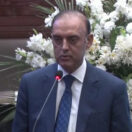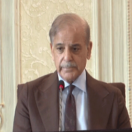By Shahbaz Rana
Published in The Express Tribune on April 03, 2024
ISLAMABAD: In a dire forecast unveiled on Tuesday, the World Bank cautioned that over 10 million additional individuals in Pakistan face the looming threat of descending into poverty.
The apprehension stems from a sluggish economic growth rate of 1.8% coupled with soaring inflation at a staggering 26% for the current fiscal year.
The Washington-based lender’s biannual Pakistan Development Outlook report painted a grim economic picture, indicating that the nation is poised to miss almost all major macroeconomic targets.
Notably, the country is anticipated to fall short of its primary budget target, remaining in deficit for three consecutive years, contrary to the International Monetary Fund’s (IMF) stipulations mandating a surplus.
Lead author of the report, Sayed Murtaza Muzaffari, highlighted that despite a broad-based yet nascent economic recovery, poverty alleviation efforts remain insufficient.
Economic growth is projected to stagnate at a paltry 1.8%, maintaining the poverty rate at around 40%, with approximately 98 million Pakistanis already grappling with poverty.
The report underlined the vulnerability of those hovering just above the poverty line, with 10 million individuals at risk of slipping into poverty in the face of shocks.
The WB said that the poor and vulnerable are likely to have benefited from the windfall gain in agricultural output but these gains were offset by continued high inflation and limited wage growth in other sectors that employ many of the poor, such as construction, trade, and transportation.
The wages of daily labourers increased only 5% in nominal terms during the first quarter of this fiscal year when the inflation was above 30%.
The persisting cost-of-living crisis coupled with rising transportation costs could potentially lead to an increase in out-of-school children and delayed medical treatments, particularly for worse-off families, warned the WB. At the same time, food security remains a concern in parts of the country, it added.
Among 43 rural districts across Khyber Pakhtunkhwa, Sindh, and Balochistan, many of which were impacted by the 2022 floods, the prevalence of acute food insecurity is also projected to increase from 29% to 32% in the third quarter of this fiscal year.
“Poverty reduction is projected to stall in the medium term due to weak growth, low real labour incomes, and persistently high inflation,” said the WB.
Chronic inflation in the absence of substantial growth, along with policy uncertainty, could cause social discontent and have negative welfare impacts, warned the Washington-based lender.
GDP growth
The World Bank said that Pakistan’s economy is expected to grow by only 1.8% in the current fiscal year ending June 2024. The official target is 3.5%.
For the next fiscal year too, the WB has projected only a 2.3% economic growth rate, which is even lower than the population growth rate of 2.6%. The lender said that the subdued recovery reflects tight monetary and fiscal policy, continued import management measures aimed at preserving scarce foreign reserves, and muted economic activity amid weak confidence.
It added that in the absence of major and sustained economic reforms, Pakistan is expected to continue to face foreign exchange liquidity issues due to the persistent trade deficit and limited access to external financing, especially from the private sector.
“Even with the recent successful completion of the IMF programme and continued rollovers of foreign debt, foreign exchange reserves are projected to remain low, hovering around 1.3 months of total imports over the three years”.
To a question, Tobias Haque, the World Bank’s lead economist, said that Pakistan has come out of the economic crisis but the outlook remains grim. He said that compared to a year ago, the economic crisis has been averted.
The report stated that macroeconomic risks remain very high amid a large debt burden and limited foreign exchange reserves.
“The structural reforms needed to durably improve the economic outlook are known. Developing a clearly articulated reform implementation plan that is ambitious, credible and that shows quick progress is now essential to restore confidence,” said Najy Benhassine, World Bank Country Director for Pakistan.
Najy said better fiscal management will help to lower inflation, narrow the current account deficit, improve financial sector stability and increase credit to the private sector, all of which are critical for robust economic recovery.
Inflation
The lender has projected inflation at 26% in this fiscal year due to higher domestic energy prices, which is far higher than the official target of 21%. For the next fiscal year too, the WB projected a 15% inflation rate.
With lower domestic demand and continued import management measures, the current account deficit is expected to remain low at 0.7% of GDP in this fiscal year –probably the only target that the government is going to achieve.
The lender said that despite easing global commodity prices, higher domestic crop production, and stability in the exchange rate, inflation pressures increased due to higher domestic energy prices and money supply growth.
Upward revisions in electricity and gas prices have substantially increased the overall cost of production. The rapid increase in money supply continues to exert inflationary pressures. The SBP injected substantial liquidity into the banking sector through Open Market Operations (OMOs), reaching Rs8.7 trillion by the end of December 2023. The credit to the public sector was 75.6% of the total bank credit.
Budget deficit
The fiscal deficit is projected to increase to 8% of GDP or Rs8.5 trillion in this fiscal year due to higher interest payments, which is far higher than the official target of 6.5%.
The WB said that the deficit will only gradually decline over the medium term as interest payments decrease and fiscal consolidation measures take hold.
As against the IMF target of a primary budget surplus of Rs400 billion, the WB said that there will be a primary deficit of 0.1% of GDP in this fiscal year. It has projected the deficit for the next two fiscal years as well.
The WB said growing exposure to the government is exposing the banking sector to risks. Despite a low CAD, the reserve position is therefore projected to further weaken, reflecting limited external financing.
The public debt as a share of GDP is projected to decline to 73.1% in this fiscal year –a threshold that is far higher than the statutory limit of less than 57% for this fiscal. It has recommended Pakistan to fully implement the Treasury Single Account to reduce the government’s cash holdings, reducing interest costs that in turn can save Rs424 billion annually.
The WB also sees a higher level of circular debt. It said that the power sector’s circular debt has continued to grow. As of the end of January 2024, the circular debt stock stood at Rs2.635 trillion, including an additional flow of Rs463 billion since end-June 2023.
Recent large accumulations began in 2018 with the signing of “take-or-pay” contracts for large, imported coal and imported gas power plants. These have increased capacity payments by 50% and increased the country’s exposure to international fossil fuel price volatility—as witnessed over 2022, it added.
Circular debt on gas has emerged as another challenge for the sector. As of January 2024, gas circular debt stood at Rs2.9 trillion compared to Rs2.4 trillion in June 2023.
While consecutive gas tariff increases have contributed to containing growth, the accumulation is a result of delays in tariff adjustment, inefficiencies in the sector and increasing diversion of expensive RLNG to domestic consumers during winter months, it added.






